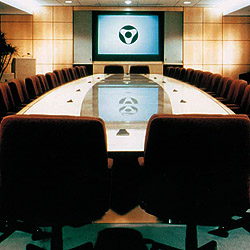
Non-Meeting Applications
Today, the life of meeting facilities extends far beyond just meetings, to include classes, plays, and social events. Sound systems can play an important role in all of these situations.
While it’s not possible to detail microphone techniques for every application, a few examples will show how to use some of the ideas already presented.
Though most classrooms are not large enough to require the use of a sound system, it is sometimes necessary to record a class, or to hold a very large class in an auditorium. In these cases, it is suggested that the teacher wear a wireless lavalier microphone to allow freedom of movement and to maintain consistent sound quality.
If it is desired to pick up the responses of students, it is possible to use area microphones in a recording application, but not with a sound system. A better technique is for questions to be presented at a fixed stand microphone, or to pass a wireless microphone to the student.
Microphone use for plays and other theatrical events involves both individual and area coverage. Professional productions usually employ wireless microphones for all the principal actors. This requires a complete system (microphone, transmitter, receiver) for each person, and the frequencies must be selected so that all systems will work together without interference.
While it’s possible to purchase or rent a large number of wireless systems, it’s often more economical to combine just a few wireless systems with area microphones for the rest of the players.
Use unidirectional boundary microphones for “downstage” (front) pickup, and use unidirectional hanging micro-phones for “upstage” (rear) pickup. Always use a center microphone, because most stage action occurs at center stage.
Use flanking microphones to cover side areas but observe the 3-to-1 rule and avoid overlapping coverage. Turn up microphones only as needed.
Social events, such as dances, generally require only public address coverage. Use unidirectional, hand-held or stand mounted microphones. Dynamic types are excellent choices, because of their rugged design.
The microphone should be equipped with an on-off switch if it is not possible to turn down the microphone channel on the sound system. In any case, turn up the microphone(s) only as needed.
Outdoor use of microphones is, in some ways, less difficult than indoor. Sound outdoors is not reflected by walls and ceilings so that reverberation is not present. Without reflected sound, the potential for feedback is also reduced.
However, the elements of nature must be considered: wind, sun, and rain. Because of these factors, dynamic types are most often used, especially in the likelihood of rain. In any case, adequate windscreens are a must.
Microphone principles are the same outdoors, so unidirectional patterns are still preferred. Finally, because of frequent long cable runs outdoors, balanced low-impedance models are required.
Conclusion
Though it is one of the smallest links in the audio chain, the microphone is perhaps the most important. As it’s the connection between sound source and the sound system, it must interact efficiently with each. Choosing this link successfully requires knowledge of sound and sound systems, microphones, and the actual application.
Through the examples given, the correct selection and use of microphones for a variety of meeting facility sound requirements has been indicated. Applying these basic principles will assist in many additional situations.
The subject of microphone selection and application for meeting facility sound systems is ever changing, as new needs are found and as microphone designs develop to meet them. However, the basic principles of sound sources, sound systems, and the microphone that links them remain the same, and should prove useful for any future application.
This article is provided by Shure.
